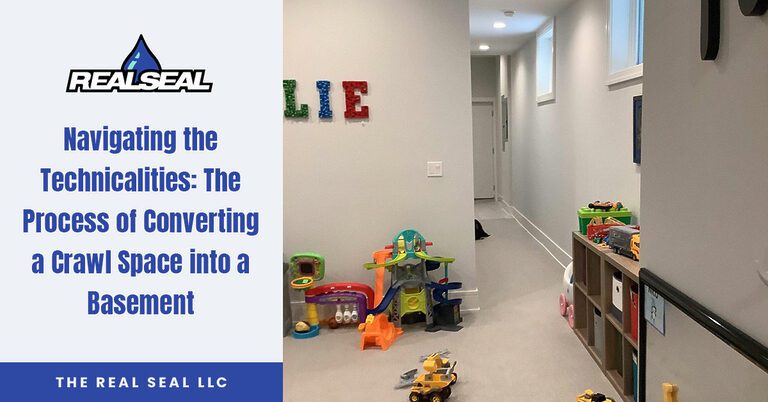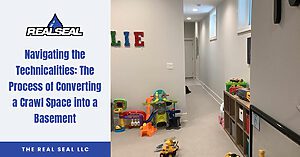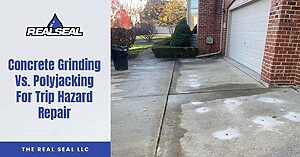There are many ways to enhance a crawl space. One of the most significant changes you can make is converting your crawl space to a basement. However, this project is not one you should take on without serious consideration.
While converting a crawl space into a basement offers many benefits, it is an extensive and challenging process. Before committing to this process, you need to know the technicalities involved and understand that each step in the process is vital to success. Skipping any step or failing to perform it properly cancause the project to fail.
As a homeowner considering the crawl space conversion process, it’s vital to understand how complex this project can be. Knowing this process provides deeper insights into the steps your foundation professional will take and helps ensure the process unfolds correctly.
Since converting a crawl space to a basement is extremely technical and time-consuming, we’ve created this article to help you understand what you’re getting yourself into by choosing this project. Read on to learn everything you need to know about the crawl space conversion process.
Assessing Your Crawl Space for Conversion
The first step in this project is to evaluate the feasibility of converting a crawl space to a basement. To conduct this step correctly, you must answer one vital question and ensure you know what’s involved in the initial assessment before crawl space conversion.
Is Your Crawl Space Suitable for Conversion?
Unfortunately, not all crawl spaces are suitable for conversion. Your crawl space must meet the requirements to qualify for this service. Before performing any other steps in the conversion process, ensure your crawl space is a viable candidate for this project by having your foundation professional assess it properly. Only after performing the assessments in the section below can you proceed with the crawl space to basement conversion.
Initial Assessments to Determine Conversion Viability
- Soil evaluation: A skilled foundation professional should assess the soil quality surrounding your crawl space before converting it. Soils must have the necessary stability to facilitate this work and support a new foundation.
- Assessment of foundation condition and type: The overall type and condition of your crawl space must also be evaluated before conversion occurs. Some foundation types are not viable for conversion, and some require significant repairs before conversion occurs. Your foundation professional should be well-equipped to assess your foundation and ensure it is a viable candidate for conversion.
- Evaluation of existing utilities: Many crawl spaces house vital utilities. Before conversion, it’s necessary to have a plan for where these utilities will exist following the conversion.
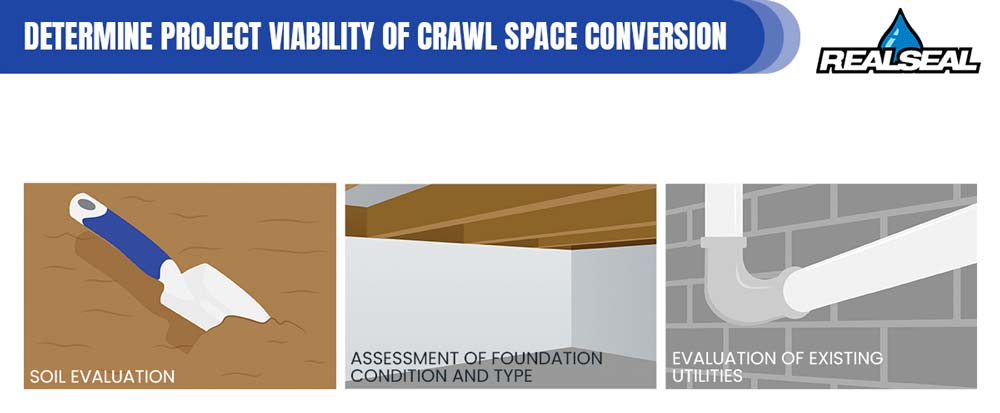
Along with those critical considerations, you’ll also need to think of other logistical factors. For example, homeowners who conduct conversion may need to find housing during the process, depending on the technique used. This need for alternative housing alone requires preparation before conversion can occur.
Planning and Permits
As you would expect, this project requires planning. Without proper planning, you cannot expect this process to be successful. The sections below will introduce you to a few of the most essential planning elements in the crawl space conversion process.
Planning Your Basement Conversion: The First Steps
- Find the right team: Finding the best team for your basement conversion is something you cannot overlook. Without a knowledgeable team, there is minimal chance your conversion is a success. Ideally, the team you choose should have past basement conversion experience.
- Develop a detailed design: Before breaking ground, the team you choose should take as much time as needed to create a thorough design of the project and the finished product. This design should reveal what the basement will look like and detail all the necessary steps to achieve that vision.
- Anticipate challenges: Even if you have a comprehensive design in place, it’s also important to anticipate any obstacles the team will face during the project. Since every project is unique, challenges can come in many forms. The better prepared your team is to deal with these challenges, the more likely they are to overcome them.
Navigating Building Codes and Permits for Your Conversion Project
Since conversion amounts to a significant change to your property, you’ll likely need approval from a local governing body before you proceed with the work. The best way to ensure you complete all necessary paperwork is to contact your local municipality and share your intentions. After learning the details of your project, a government official will be able to guide you through the completion of the necessary permits and paperwork.
The Excavation Process
After completing the necessary preparation, it’s time to begin the excavation process for basement conversion. While excavation seems like a simple task, a crawl space dig-out is more complex than you might expect. Read on to learn some of the specific challenges you can expect when digging out a crawl space.
Excavating Your Crawl Space: What to Expect
Before performing excavation, it’s necessary to provide an alternative form of support for your home. Foundation teams often achieve this goal by installing I-beams or scaffolding to hold your home while the foundation work occurs. Alternatively, the dig out can be accomplished in 4-5 foot sections under the foundation at a time, eliminating the need for traditional cribbing.
When your home has the support it needs, it’s time to begin the crawl space dig out. This process involves excavating below your home and removing all unneeded portions of your crawl space. The foundation team will also usually need to excavate to a depth of at least 4 to eight feet to ensure the basement will be full-sized.
After excavating, your team will create a full basement foundation and connect it to the remaining portions of your crawl space. The foundation expert can use poured concrete, masonry, or another material to create your full basement.
The Challenges of Digging Out a Basement
Even if you perform careful planning, there are issues that can occur during excavation. Below are some of the most common challenges a foundation team may face when converting a crawl space:
- Water management: The presence of groundwater can be a severe problem that makes excavation extremely difficult, if not impossible. Additionally, your foundation team will need to manage water throughout the excavation process. Since the team will need to create a hole under your home, it’s easy for water to flow into it. Keeping water out is essential to the success of this project.
- Damage to the existing structure: During a crawl space dig out, it is far too easy to cause damage to existing home structures. Since many of those structures will be necessary for your future basement, any damage can be detrimental to the overall success of the project.
- Unforeseen underground obstacles: Even with proper planning, your foundation team may encounter unexpected obstacles underground that make excavation challenging.
Along with those challenges, digging out crawl spaces is also a hazardous process. During excavation, the foundation team will work directly underneath the home, meaning that dependable supports are vital. Thankfully, experience and proper planning can mitigate and eliminate many of these challenges.
Foundation and Structural Support
The primary purpose of a foundation is to provide support for your home. However, during a crawl space conversion, your foundation will be incapable of performing that essential role. Since that’s the case, it’s necessary to provide structural support for crawl space conversion.
Reinforcing your Home’s Foundation for a Basement Conversion
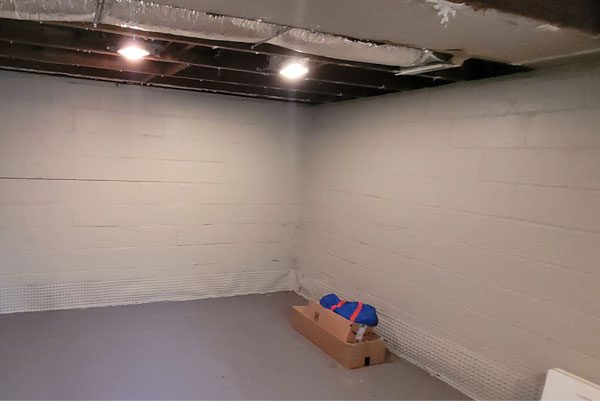
Before performing a conversion, you’ll need a reliable form of foundation reinforcement. Earlier, we noted the importance of temporary structural support, but it’s important to cover the details of what that involves.
Some foundation teams choose to dig out a crawl space in sections that are about four feet wide. In such cases, full cribbing is not necessary, as your foundation can still hold the structure above with these minimal sections being worked on.
Alternatively, if the foundation team chooses to excavate the entire foundation space and pour the full basement all at once, the best approach is to use scaffolding or cribbing. These systems provide the ideal temporary support a home needs to remain intact during conversion.
Ensuring Structural Integrity During and After Conversion
Just as it is essential to anticipate structural needs before the conversion takes place, it’s also important to provide stability during and after the conversion. As mentioned above, using I-beams, scaffolding, or cribbing are three of the best ways to provide temporary support. However, there are other supports that may be necessary after the conversion.
For example, your converted basement may require new footings. These footings rest at the bottom of your foundation and are responsible for providing strength and support.
Additionally, some homes also require underpinning. Underpinning involves the installation of foundation piers. These piers are inserted deep into the ground until they reach firm strata. The piers also connect to the home’s foundation. This connection grants increased stability for the home and makes it very unlikely that settlement will occur.
Waterproofing and Final Touches
Now that the main portions of the conversion process are complete, it’s time to consider a few final touches that will dramatically improve your new basement foundation. These final touches help prevent moisture-related problems and make your basement as useful as possible.
Keeping Your New Basement Dry: Waterproofing Solutions
Basement waterproofing is a service that should be involved in all crawl space conversions. Waterproofing involves installing a vapor barrier that creates a seal between your basement and the outside. This seal makes it very difficult for water to enter. Waterproofing also helps ensure good air quality in your basement and makes it more enjoyable to spend time in.
The Finishing Touches: Making Your Basement Livable
After waterproofing your basement, it’s also a good idea to finish it fully. Finishing a converted basement involves installing flooring, appliances, lighting, insulation, and other features that allow your basement to be a viable living space.
One of the greatest benefits of a full basement is that it provides an entirely new floor that you can live in. You may rent this space, use it yourself, or treat it as a storage area. Additionally, a finished basement can dramatically increase the value of your home.
While finishing a basement takes more time and money, the results are often worth it. After all, having a finished basement is one of the leading motivating factors for people to seek conversion.
Get Guidance from a Professional
Completing crawl space to basement conversion is not something that you can do without the help of an expert. As this article proves, the crawl space conversion process is extremely technical and can include many challenges.
Learning the nuances of this process is an excellent start for any homeowner who wants to convert their crawl space to a basement. However, working side-by-side with a trusted professional is equally important. If you are in the Chicagoland area and considering crawl space conversion, reach out to The Real Seal, LLC as your first step. We have the knowledge and experience needed to see if conversion is possible and ensure that your project succeeds.
